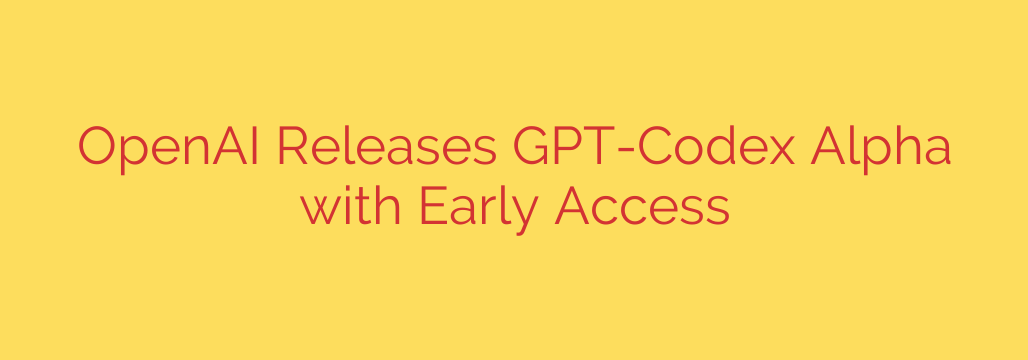
How AI is Revolutionizing Software Development: A Deep Dive into Natural Language Coding
The world of software development is on the cusp of a monumental shift, driven by advances in artificial intelligence. A new class of AI models is emerging that can understand natural language—like plain English—and translate it directly into functional computer code. This technology promises to redefine developer productivity, lower the barrier to entry for aspiring coders, and fundamentally change how we build applications.
At the forefront of this innovation is a powerful AI system trained on a massive dataset of both text and publicly available code. By analyzing billions of lines of code from sources across the internet, this model has learned the patterns, syntax, and logic of numerous programming languages. The result is an AI that acts as an incredibly proficient programming partner, capable of turning simple instructions into complex scripts.
From Simple Commands to Complex Code
So, how does this work in practice? Imagine you need to build a small feature for a website. Instead of manually writing out every line of HTML, CSS, and JavaScript, you could simply describe what you want.
For example, a developer could give the AI a command like, “Create a webpage with a title that says ‘Welcome to My App’ and a red button that shows an alert ‘Hello, World!’ when clicked.”
The AI would then process this request and generate the corresponding code, ready to be implemented. This capability extends far beyond simple web elements. Developers can use it to:
- Generate complex functions: Request a Python function to parse a specific data file or an SQL query to retrieve information from a database.
- Translate between languages: Instantly convert a block of code from Java to Python or from JavaScript to Ruby, saving hours of painstaking manual work.
- Complete code and suggest next steps: The AI can act as an advanced auto-complete, understanding the context of your code to suggest the most logical next lines or entire functions.
- Explain existing code: By feeding the model a confusing code snippet, you can ask for a plain English explanation of what it does, making it an invaluable learning and debugging tool.
The Impact on Developer Productivity and Workflow
For professional developers, this technology is not a replacement but a powerful “copilot.” It automates the tedious, repetitive, and boilerplate aspects of coding, freeing up developers to focus on higher-level problem-solving, system architecture, and creative logic.
Key benefits for the tech industry include:
- Accelerated Prototyping: Ideas can be turned into functional prototypes in a fraction of the time, allowing for faster iteration and innovation.
- Reduced Boilerplate: Developers can spend less time writing standard, repetitive code and more time on the unique, challenging aspects of a project.
- Enhanced Learning and Onboarding: Junior developers can use the tool to understand complex codebases and learn best practices more quickly.
- Increased Accessibility: Individuals with great ideas but limited coding experience can begin to build simple applications and scripts, democratizing software creation.
Navigating the Risks: Important Security Considerations
While the potential is enormous, it’s crucial to approach AI-generated code with a healthy dose of caution. An AI model is only as good as the data it was trained on. If it learned from code containing security flaws or bad practices, it can replicate those mistakes in its output.
Blindly trusting and implementing AI-generated code without review can introduce serious security vulnerabilities into your applications.
Actionable Security Tips for Using AI Coding Assistants:
- Always Audit the Output: Treat AI-generated code as if it were written by a new team member. You must review, test, and understand every line before deploying it to a production environment.
- Scan for Vulnerabilities: Use static analysis security testing (SAST) tools and other security scanners to automatically check the generated code for common vulnerabilities like SQL injection, cross-site scripting (XSS), or insecure data handling.
- Don’t Outsource Critical Thinking: Use the AI to handle grunt work, but never let it make critical architectural or security decisions. The developer’s expertise is still paramount.
- Stay Educated on Secure Coding: The best defense against insecure AI suggestions is a deep understanding of secure coding principles. This knowledge allows you to spot potential issues that the AI might miss or introduce.
The Future is a Collaboration
The rise of AI code generators marks a new era in software development—one defined by human-AI collaboration. These tools are poised to become a standard part of every developer’s toolkit, much like compilers and integrated development environments (IDEs) are today. By handling the mundane and accelerating the complex, this technology will empower a new generation of builders to create faster, smarter, and more innovative software than ever before.
Source: https://www.bleepingcomputer.com/news/artificial-intelligence/openai-rolls-out-gpt-codex-alpha-with-early-access-to-new-models/








